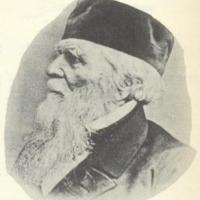
Evans and Göring: Gambiteers
In 1824 William Davies Evans (pictured here) of Wales was captain of the first Royal Mail steam ship, christened the Auckland, that made a run from Milford Haven to Waterford. Like all sailing men he was faced with a choice of diversions when cooped up with other young, healthy and lusty young men for long periods aboard ship. In Evans’ case he chose to amuse himself with Lt. Harry Wilson. The two of them played chess, which is probably the healthier of the alternatives at their disposal. With nothing better to do on this voyage, Evans began to contemplate – as would you or I – the lines that ensue from the Italian opening: 1. e4 e5 2. Nf3 Nc6 3. Bc4 Bc5
And Evans, a good chess player, but certainly not world class, hit upon an innovation that would last to this day and be played at the highest levels of the game. The innovation in question was 4. b4, sacrificing the pawn. In 1826 Evans showed this innovation in London to William Lewis (operator of the Turk) and Lewis’ student, the famed Irish player Alexander McDonnell, stunning everyone by defeating the latter.
The numerous luminaries who have played the Evans Gambit include La Bourdonnais, Staunton, Morphy, Anderssen, Bird, Blackburne, Zukertort, Steinitz, Winawer, Tarrasch, Chirgorin, Lasker, Tartakower, Fischer, Bronstein, and Kasparov. I also note that our esteemed chess.com members Bill Wall and Yelena Dembo have played it successfully.
Evans had an interesting life. Imagine entering the service of the Royal Navy at the ripe old age of 14, which Evans indeed did until the Napoleonic wars ended in 1815. About that time he entered the service of the Postal Department and he became a captain when he was only 29 years old. He must have been a fine sailor. At age 50 he retired on a pension due to ill-health, but engaged in that fine tradition of double-dipping by captaining a steam ship in the Mediterranean for 2 years out of Greece.
In the May 1883 issue of British Chess Magazine, there appears an article with the following anecdote:
“On one occasion when I had just commenced a game at the Divan I observed an elderly gentleman suddenly raise his hat from his head and put it on again. He did this in a way to excite my curiosity, and on my venturing to ask him why he had done so he replied, “I am Capt. Evans, and whenever I see anyone playing my gambit I always acknowledge the compliment by taking off my hat”.’
In the summer of 1996 I spent a beautiful day on a sailboat in the North Sea off the coast of Belgium, consumed a bowl of steaming mussels swimming in white wine with Belgian fries by the seaside, and slept on the boat that night while docked in Ostend. I knew not that a short distance away in the cemetery of that charming coastal town a headstone had been standing guard since 1872, silently bearing the following inscription:
“To the sacred memory of William Davies Evans, formerly Commander in the Post Office and Oriental Steam Services; Superintendent in the Royal Mail Steam Company, and inventor of the system of tri-coloured light for shipping. Also well known in the chess world as the author of the Evans’ Gambit.”
Below you can see Captain Evans defeating McDonnell in dramatic fashion while playing the innovation that has made him immortal.
There is a line of the Evans Gambit attributed to Carl Theodor Göring of Germany and which is referred to as the Göring Attack. But there is an independent gambit that bears Göring’s name. The Göring Gambit (a variation of the Scotch game) begins: 1. e4 e5 2. Nf3 Nc6 3. d4 exd4 4. c3
But as we have previously seen with other openings named after real people, the Göring Gambit was not invented by Göring. The Oxford Companion to Chess says that the Göring gambit was first played by Staunton in the 1840’s and “adopted by Göring later.”
Whenever I read something like this it titillates my hope gene. If I myself adopt some obscure line of the Sicilian and become identified with it, will that line be dubbed “the Godden”? If so, I shall forevermore acknowledge the compliment by taking off my hat to anyone whom I see playing it.
But let us return to Göring. He was a German chess master who lived from April 1841 to April 1879. All chess players are philosophers of a sort, but Göring was an actual professor of philosophy at the University of Leipzig, where he taught Empiricism and Posivitism. These are perfect disciplines for a chess master to espouse, given that they are grounded in the trust of experience and experimentation. Presumably it was this mindset that allowed him to invent the Göring Attack mentioned above.
Göring placed among the top 5 in many tournaments, defeated the famed Adolf Anderssen in 1887 and was a co-founder of the German Chess Federation.
The only child of a wealthy family, Göring did not have any worries about his material needs, only his physical. Sadly, the latter risk became a reality in 1872 when he was stricken by a case of rheumatism leading to severe depression. He committed suicide in Eisenach.
Here is Göring using “his” gambit to defeat an unnamed opponent in 1877 in the beautiful city of Cologne that straddles the Rhine river.
This blog is one of a continuing series that discusses the players whose names grace many openings. Here are the links to these blogs published to date:
The Names behind the Openings, Part 1
Bird to Bogo
Caro, Kann and Chigorin – Openings Players
Evans and Göring: Gambiteers
Who was Giuoco Piano?

